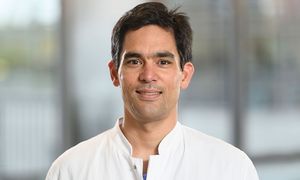
Central service project in KFO 5001
Findings from the first funding period
During the previous funding period (FP1), the PZ established a qualification program for Clinician Scientists, developed advanced human dorsal root ganglion (DRG) magnetic resonance imaging techniques (MRI - structural and functional imaging), and built platforms for skin and blood biomarker analysis. The studies provided insights into neuropathic pain conditions like CRPS, chronic postsurgical surgical pain (CPSP following inguinal hernia repair), Bortezomib-induced peripheral neuropathy (BIPN), and neuropathic Pain induced by anti-Caspr2 autoantibodies, confirming DRG pathologies and defining biomarker profiles in skin biopsies and in the blood associated with pain persistence and resolution.
Research Objective
- Education: Advance the training program for Advanced Clinician and Medical Scientists.
- Clinical Studies: Extend longitudinal studies on CRPS and CPSP to validate established and define novel predictors of pain resolution as a basis for future interventional trials.
- Imaging: Longitudinal DRG imaging in CRPS and CPSP patients using functional MRI (fMRI).
- Skin and Blood Analysis: Apply established analysis methods on the patient cohorts and introduce novel analytical techniques (including spatial transcriptomics, spectral flow cytometry and proteomics).
Significance
This project integrates advanced imaging, molecular profiling, and clinical research to deepen the understanding of pain mechanisms across different conditions. By strengthening training pathways and refining methodological platforms, the NPZ aims to advance the field of translational pain research and foster innovation. The project's findings may pave the way for personalized treatment strategies and innovative interventional studies, with the long-term goal of improving outcomes for patients suffering from chronic pain.
Research team NPZ
Head
Prof. Dr. Alexander Brack, MD
Deputy Director of the Department of Anesthesiology, Intensive Care, Emergency and Pain Medicine
University Hospital Würzburg
Univ.-Prof. Dr. Mirko Pham, MD
Director of the Institute of Neuroradiology
University Hospital Würzburg
Univ.-Prof. Dr. Nicolas Schlegel, MD
Chair of Experimental Visceral Surgery
University Hospital Würzburg
Members of the team
Carolin Dorsch, PhD Student
Florine Feurer, PhD Student
Dr. rer. nat. Julia Grüner, Researcher
Dr. Florian Hessenauer, MD, Clinician Scientist
Eva Herrmann, PhD Student
Yuying Jin, PhD Student
Bente Landenberger, PhD Student
PD Dr. Michael Meir, PhD, Researcher
Dr. Magnus Schindehütte, MD, Clinician Scientist
Jonathan Weippert, PhD Student
Larissa Bischof, PhD Student
Friedrich Krepiev, Clinician Scientist
Regina Pistorius, Clinician Scientist
Ann-Sophie Redinger, PhD Student
Anna Ryskal, Clinician Scientist
Xinyu Zhang, Clinician Scientist
Lisa Schulz, PhD Student
Jacopo Stickdorn, PhD Student
Selected publications
Dietz C, Müller M, Reinhold AK, Karch L, Schwab B, Forer L, Vlckova E, Brede EM, Jakubietz R, Üçeyler N, Meffert R, Bednarik J, Kress M, Sommer C, Dimova V, Birklein F, Rittner HL (2019)
What is normal trauma healing and what is complex regional pain syndrome I? An analysis of clinical and experimental biomarkers.
Pain. 2019 Oct;160 (10): 2278-2289
Go to publication
Egenolf N, Zu Altenschildesche CM, Kreß L, Eggermann K, Namer B, Gross F, Klitsch A, Malzacher T, Kampik D, Malik RA, Kurth I, Sommer C, Üçeyler N (2021)
Diagnosing small fiber neuropathy in clinical practice: a deep phenotyping study.
Ther Adv Neurol Disord. 2021 Mar 23;14:17562864211004318.
Go to publication



